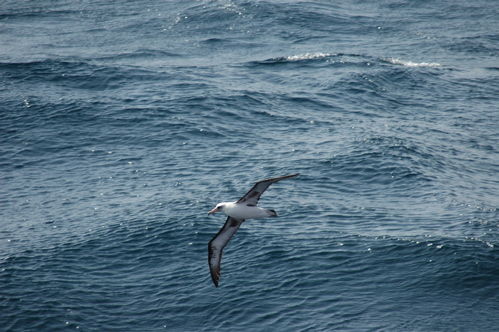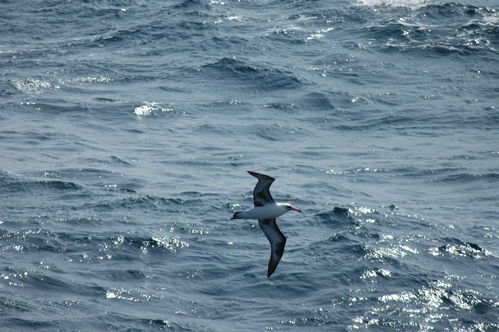Latitude: 59 32.611N Longitude: 175 09.250W "And a good south wind sprung up behind; The Albatross did follow, And every day, for food or play, Came to the mariner's hollo!" - Samuel Taylor Coleridge, The Rime of the Ancient Mariner
The stormy waters are a thing of the past today as we glide across the open water chasing the "algae bloom" (more on that soon). Sediment traps were picked up by small boat, we multi-cored at 4am and equipment traveled off and on the boat without high winds trying to snatch things out to sea. Between deployments, the fantail even became a whale-spotting and "sunbathing" locale for some.
Healy-travelers weren't the only ones enjoying the marvelous weather following a stormy weekend. Sea birds rested on the relatively calm water and flew alongside the boat with ease. One kind of bird stood out from the usual flocks of Glaucous Gulls and Fulmars circling the bow though. With a wingspan of over 6 feet, the Laysan Albatross (Phoebastria immutabilis) stole the show from the lesser-sized birds, swooping down and nearly touching the whitecaps. Three regal albatrosses gliding in circles around the Healy, seemed to be enjoying the day- flying without destination but merely for the enjoyment of being above the sea.
The Laysan Albatross is found worldwide from Japan to the North Pacific. These birds often travel long distances over open-ocean without resting for many days. They can sustain flight for many hours by locking their wings in place and riding the updrafts for miles. Home is the open ocean. Afterall, there's plenty to eat here! This type of albatross generally feeds on cephalopods (like octopus and squid), fish and crustaceans. Maybe that's what this one is looking for...
 Notice the shading around this albatrosses eyes. Why do you think this is so? Think sunglasses!
Notice the shading around this albatrosses eyes. Why do you think this is so? Think sunglasses!
During their nearly 40 year life span, these albatrosses only return to land for breeding. Following elaborate mating and breeding rituals, albatrosses only lay one egg per breeding season and often take a up to a year to raise their chick. The Laysan Albatross mates for life and the couple works together to incubate the egg as well as raise their chick. Hatching in a sandy nest, the chick will depend on its parents for food until it heads to sea, not to return for three to five years!
Conservation groups worldwide are working hard on behalf of these majestic birds. Ocean flotsam, or trash, is also major problem for all types of albatrosses. Often mistaking pieces of floating trash for food, albatrosses ingest all sorts of terrifying snacks; fish hooks, bottle caps and cigarette lighters. Even if the parent bird does not get sick, the feeding chick is still at risk when daddy or mommy returns to their hungry baby with a toxic meal!
Check out savethealbatross.net for more information about the problem and what can be done to help Albatrosses around the globe!
 What is the shape of this albatrosses beak? Why do you think it is shaped this way?
What is the shape of this albatrosses beak? Why do you think it is shaped this way?
